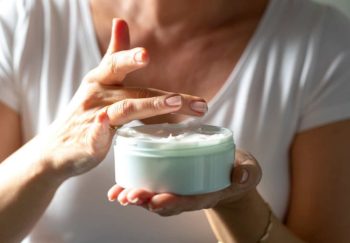When you were a kid, did you enjoy peeling a sunburn? Were you too cool for sunscreen? Did you visit tanning beds before Prom? Whatever your history with sun exposure, if you're a parent, you know the sunburn facts. You've got the SPF 50 in your pocket, and you're not afraid to use it.
That's a good thing. Sunburns early in life can lead to skin cancer, including dangerous melanoma.
“Unfortunately, sun exposure that we had as children puts us at the highest risk for melanoma as an adult,” says surgical oncologist Lynn Dengel, MD. She’s part of the melanoma treatment program at UVA Health.
Sunburn Facts: Doubling the Risk of Melanoma
You more than double your melanoma risk by having:
- 5 or more sunburns
- 1 blistering sunburn in childhood or adolescence
These facts come from the Skin Cancer Foundation.
These data points may inspire you to double down on your kid's sun protection. But what about you? How many sunburns did you have as a kid? Should you worry?
Why Worry About Melanoma?
Melanoma starts in the skin cells that make the pigment called melanin. Melanin's job is to protect our skin from the sun's ultraviolet rays.
Some types of melanoma can spread beyond the skin. We call this invasive melanoma. It’s on the rise in the U.S. About 98,000 Americans will be diagnosed with invasive melanoma this year.
We’ve come a long way in treating melanoma. Still, almost 8,000 people in the U.S. will die from melanoma in 2023, according to the Skin Cancer Foundation.
From the sun or tanning devices, UV radiation ranks among plutonium & cigarettes as known carcinogens, according to International Agency for Research on Cancer.
Why Are Sunburns So Damaging?
We’ve heard of harmful radiation leaking from nuclear powerplant meltdowns. But the sun gives off radiation too. It’s an invisible form of energy called ultraviolet (UV) radiation. Tanning beds also emit UV radiation — in amounts 10 to 15 times higher than the sun at its peak intensity.
When we don’t protect our skin from UV radiation, it can damage the DNA in our skin cells. This can lead to genetic mutations. These can lead to skin cancer. UV rays can also damage the eyes, causing cataracts and eyelid cancer.
UV radiation is a proven human carcinogen. Like cigarettes, it’s a definite cause of cancer. And like cigarettes, it doesn’t immediately cause cancer. It takes years of exposure.
Another scary fact: More people develop skin cancer because of indoor tanning than develop lung cancer because of smoking. (Virginia is among 20 states that ban indoor tanning for those under 18).
Parents: Have YOU Been Screened?
Get screened for skin cancer.
Easy Ways to Protect Your Kids from Skin Cancer
But here’s the good news. Sunburns are totally preventable.
Here’s a fun fact: Regular daily use of an SPF 15 or higher sunscreen reduces your risk of getting melanoma by 50%.
When Out Enjoying the Sun
- Lather on broad-spectrum sunscreen, even on cloudy days (UV radiation can penetrate clouds) Spray sunscreens make it easier to apply to wiggly kids.
- Don’t forget the lips. Use a lip balm with sunscreen.
- Wear sunglasses or hat.
- Don’t sit out in the sun all day.
“Sun protection is so important,” says Craig Slingluff, MD, a UVA Cancer Center doctor. He’s devoted his career to looking for better ways to fight melanoma and caring for people with melanoma. His patients include women in their 20s who tanned a lot.
He adds, “Doing the things you love to do in the sun is important. But making a special point to get sun just to have darker skin can lead to extra trouble.”



Yes, burns are unhealthy, but so is avoiding the sun entirely. As studies reveal many populations have critically low Vitamin D levels, largely due to insufficient sun exposure, educated medical professionals are reversing their previous recommendation to always wear sun protection, and instead are advising a minimum daily dose of 20 minutes of unprotected sun each day. Not long enough to burn, but enough time to get the amazing health benefits of sunshine. Those with darker skin can remain in the sun longer; the darker your skin, the longer it takes for it to make the vitamin D your body needs, so besides tolerating more time in the sun, it needs more time in the sun.
Here are some fascinating health benefits from getting adequate sunlight, according to studies:
* Improves mental health. Getting regular sunshine significantly reduces anxiety and depression, actually increasing our serotonin (the “feel good hormone”).
* Increases bone strength. Sunlight not only increases bone density, it also enhances bone flexibility so bones are less likely to break if we fall.
* Improves sleep quality. Getting sunlight (without sunglasses) early in the day is important to healthful circadian rhythms, helping us be alert during the day and sleepy at night.
* Decreases risk of cancers. Abundant research shows strong correlations between low sunlight exposure and many cancers.
* Improves metabolic health. Getting routine sun exposure reduces our risk for obesity, type 2 diabetes, and fatty liver disease.
* Protects cardiovascular health. Produced in the body through sun exposure, nitric oxide reduces inflammation in our blood vessels and protects against arterial plaque formation.
* Improves immune function. Not only does routine sun exposure mean adequate vitamin D, which is vital to a strong immune system, but sunlight itself kills pathogens (viruses, bacteria, fungus) in the body.
* Decreases autoimmune diseases. Sunlight not only reduces our risk for developing autoimmune conditions, but it also reduces symptoms in existing cases.
* Taller kids. Children of women who get more sunlight during pregnancy actually grow up to be taller.
* Improves wound healing. Studies show faster and more complete healing when we get enough sunshine.
* Lowers blood pressure. Simply getting daily sun exposure can lower systolic blood pressure by up to 10 points.
I think it’s important to not try to scare readers into avoiding the sun, because you put them in the path of a variety of dangerous chronic conditions. I urge any future articles you publish be more nuanced. Remind people of the benefits of sunshine. Still urge them to carefully avoid sunburns, and offer practical suggestions. Remind them that many sunscreens contain concerning chemicals (according to the FDA and the EU), and point them toward the ones with ingredients “generally regarded as safe” (see below).
In case you aren’t aware, many sunscreens are now suspected of causing more problems than they prevent. Oxybenzone, found in most sunscreens, has been shown in rat studies to increase risk for tumors. This and several other common sunscreen ingredients are also suspected of disrupting normal hormone function. In 2019, the FDA stated that only two sunscreen ingredients, zinc oxide and titanium dioxide, are generally recognized as safe and effective, while the other 12 active sunscreen ingredients raise concerns and need additional testing.
And a 2020 FDA-led study showed that sunscreen ingredients including avobenzone, oxybenzone, octocrylene, homosalate, octisalate, and octinoxate are absorbed into the bloodstream and remain in the body for weeks at concentrations higher than FDA safety thresholds. The European Union recently set limits on levels of three chemicals used in sunscreens; US sunscreens contain these chemicals at levels several times higher than the limits allowed in European products.
There are right ways and wrong ways to avoid sunburns. As Hippocrates said, “first, do no harm.” The liberal and frequent application of penetrating, toxic chemicals over much of our skin can cause long-term harm, and with so many better options for avoiding burns, why risk potential serious effects from exposure to these chemicals?
As consumers increasingly become aware that it doesn’t make sense to use sunscreens that may be harmful to their health, more and more skin care companies offer sunscreens containing only zinc oxide and/or titanium dioxide, the two sunscreen ingredients with no worrisome characteristics. These compounds, sometimes called mineral sunscreens, stay on the surface of the skin instead of being absorbed, as chemical sunscreens are. And in response to consumer demand, many companies now offer mineral sunscreens that do not leave a ghostly white cast on the skin. I have found a variety of glamorous mineral sunscreens and sweat and water resistant brands.
Referring back to your article, I don’t believe any of the safe sunscreens comes in a spray, but I’d rather take the bother of annointing my squirmy child with lotion than to load their body with concerning ingredients.
We appreciate your feedback. The Environmental Working Group offers a guide on the safest sunscreens. https://www.ewg.org/sunscreen/